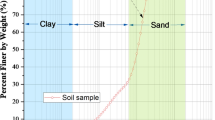Abstract
In order to study the reliability of the empirical estimation of joint shear strength by the JRC (joint roughness coefficient)-JCS (joint compressive strength) model, natural rock joints of different lithologic characteristics and different sizes were selected as samples, and their shear strengths under dry and saturated conditions were measured by direct shear test and compared to those estimated by the JRC-JCS model. Comparison results show that for natural rock joints with joint surfaces closely matched, the average relative error of joint shear strength between empirical estimation and direct shear test is 9.9%; the reliability of the empirical estimation of joint shear strength by the JRC-JCS model is good under both dry and saturated conditions if the JRC is determined accounting for directional statistical measurements, scale effect and surface smoothing during shearing. However, for natural rock joints with joint surfaces mismatched, the average relative error of joint shear strength between empirical estimation and direct shear test is 39.9%; the reliability of empirical estimation of joint shear strength by the JRC-JCS model is questionable under both dry and saturated conditions.
Similar content being viewed by others
References Cited
Amadei, B., Wibowo, J., Sture, S., et al., 1998. Applicability of Existing Models to Predict the Behavior of Replicas of Natural Fractures of Welded Tuff under Different Boundary Conditions. Geotech. Geo. Eng., 16(2): 79–128
Bandis, S., Lumsden, A. C., Barton, N. R., 1981. Experimental Studies of Scale Effects on the Shear Behavior of Rock Joints. Int. J. Rock Mech. Min. Sci. Geomech. Abstr., 18(1): 1–21
Barton, N., 1973. Review of a New Shear Strength Criterion for Rock Joints. Eng. Geol., 7(4): 287–332
Barton, N., Bandis, S., 1990. Review of Predictive Capabilities of JRC-JCS Model in Engineering Practice. In: Barton, N., Stephansson, O., eds., Rock Joints. Balkema, Rotterdam. 603–610
Barton, N., Choubey, V., 1977. The Shear Strength of Rock Joints in Theory and Practice. Rock Mech. Suppl., 10(1–2): 1–54
Du, S. G., Hu, Y. J., Hu, X. F., 2009. Measurement of Joint Roughness Coefficient by Using Profilograph and Roughness Ruler. Journal of Earth Science, 20(5): 890–896
Fardin, N., Stephansson, O., Jing, L. R., 2001. The Scale Dependence of Rock Joint Surface Roughness. Int. J. Rock Mech. Min. Sci., 38(5): 659–669
Geertsema, A. J., 2002. The Shear Strength of Planar Joints in Mudstone. Int. J. Rock Mech. Min. Sci., 39(8): 1045–1049
Grasselli, G., Egger, P., 2003. Constitutive Law for the Shear Strength of Rock Joints Based on Three-Dimensional Surface Parameters. Int. J. Rock Mech. Min. Sci., 40(1): 25–40
Homand, F., Belem, T., Souley, M., 2001. Friction and Degradation of Rock Joint Surfaces under Shear Loads. Int. J. Numer. Anal. Mech. Geomech., 25(10): 973–999
Jiang, Y. J., Li, B., Tanabashi, Y., 2006. Estimating the Relation between Surface Roughness and Mechanical Properties of Rock Joints. Int. J. Rock Mech. Min. Sci., 43(6): 837–846
Kwon, T. H., Baak, S. H., Cho, G. C., 2004. Shear Behaviour of Idealized Rock Joints: Microscale Analysis. Tunnelling and Underground Space Technology, 19(4–5): 535
Lee, S. W., Hong, E. S., Bae, S. I., et al., 2006. Modelling of Rock Joint Shear Strength Using Surface Roughness Parameter, Rs. Tunnelling and Underground Space Technology, 21(3–4): 239
Unal, M., Unver, B., 2004. Characterization of Rock Joint Surface Degradation under Shear Loads. Int. J. Rock Mech. Min. Sci., 41(3): 380–381
Wang, J. G., Ichikawa, Y., Leung, C. F., 2003. A Constitutive Model for Rock Interfaces and Joints. Int. J. Rock Mech. Min. Sci., 40(1): 41–53
Wines, D. R., Lilly, P. A., 2003. Estimates of Rock Joint Shear Strength in Part of the Fimiston Open Pit Operation in Western Australia. Int. J. Rock Mech. Min. Sci., 40(6): 929–937
Zhao, J., 1997. Joint Surface Matching and Shear Strength, Part B: JRC-JMC Shear Strength Criterion. Int. J. Rock Mech. Min. Sci. Geomech. Abstr., 34(2): 179–185
Author information
Authors and Affiliations
Corresponding author
Additional information
This study was supported by the National Natural Science Foundation of China (Nos. 40672186, 50809059), and the Natural Science Foundation of Zhejiang Province (No. Y505008), China.
Rights and permissions
About this article
Cite this article
Du, S., Hu, Y., Hu, X. et al. Comparison between empirical estimation by JRC-JCS model and direct shear test for joint shear strength. J. Earth Sci. 22, 411–420 (2011). https://doi.org/10.1007/s12583-011-0193-6
Received:
Accepted:
Published:
Issue Date:
DOI: https://doi.org/10.1007/s12583-011-0193-6




